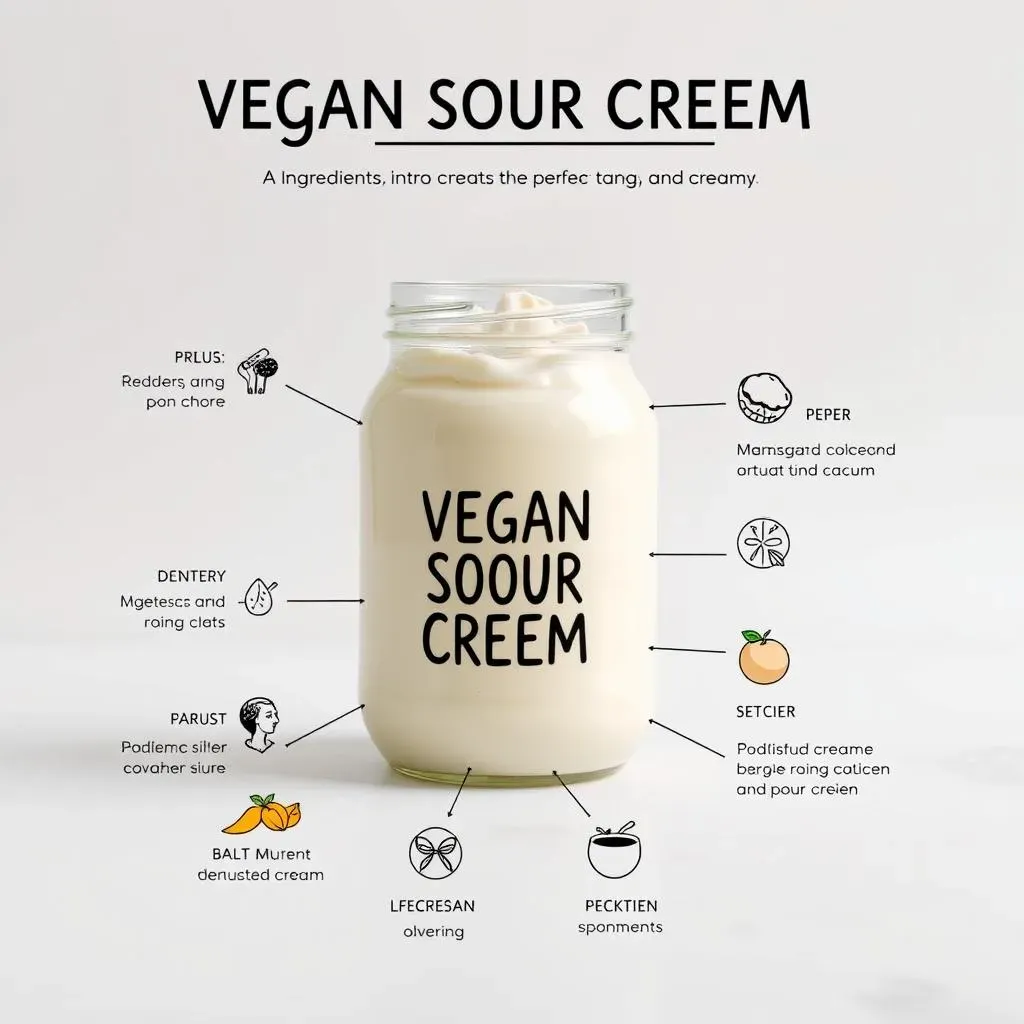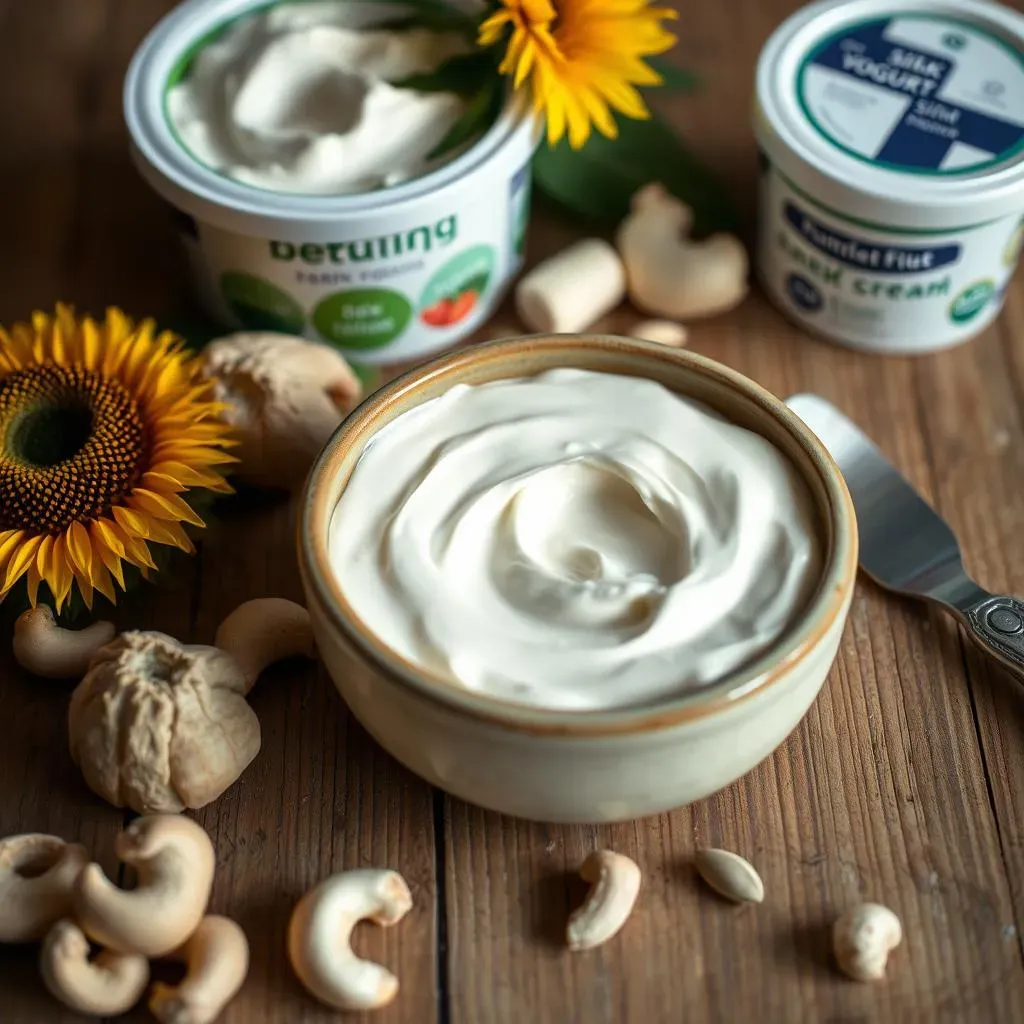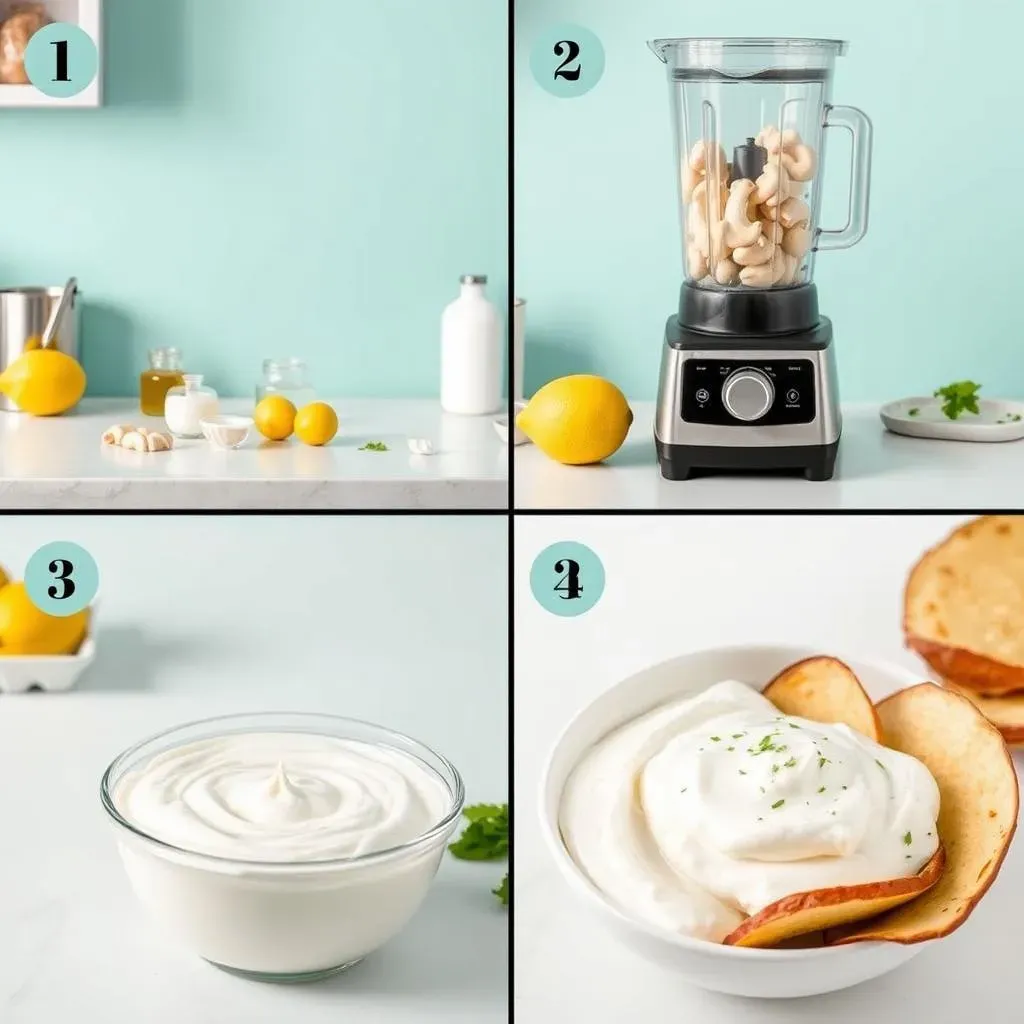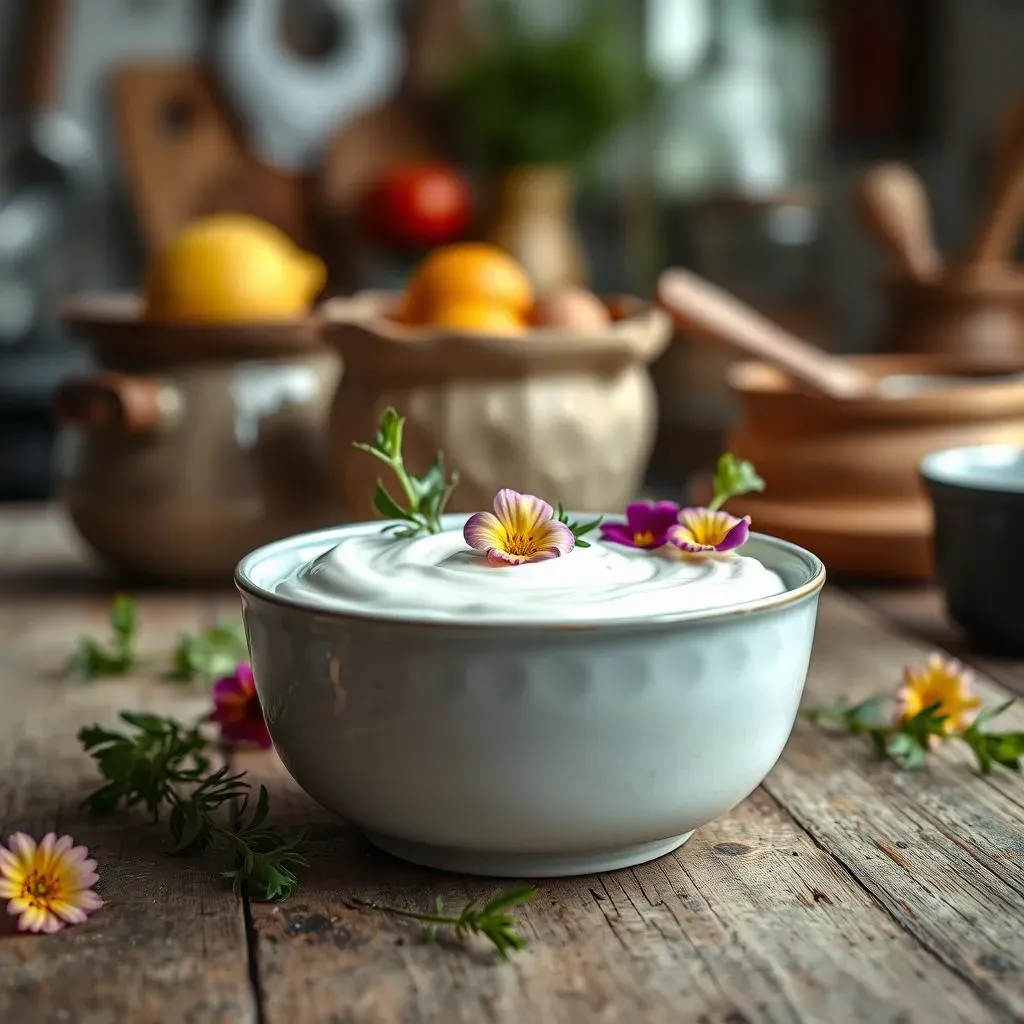Table of Contents
Craving that creamy, tangy dollop of sour cream but living the vegan life? You're not alone! Many of us miss that classic flavor and texture, especially when it's time for tacos or baked potatoes. But here's the good news: you can easily create a fantastic vegan version at home. This article will guide you through the world of vegan sour cream ingredients, demystifying what goes into making this dairy-free delight. We'll explore the core components, like cashews and other alternatives, and how they work together to achieve that perfect sour cream consistency and taste. We’ll also provide a simple, step-by-step recipe so you can whip up your own batch. Plus, I'll share some tips, tricks, and even some reader reviews to help you perfect your vegan sour cream game. Get ready to ditch the dairy and embrace the deliciousness of homemade vegan sour cream!
Understanding Vegan Sour Cream Ingredients

Understanding Vegan Sour Cream Ingredients
The Quest for Tang and Creaminess
Okay, so you're trying to figure out this whole vegan sour cream thing, right? It’s not just about slapping some plant-based stuff together and hoping for the best. It's a bit of a science experiment, but a delicious one! The main challenge is nailing that signature tangy flavor and that thick, luxurious texture we all associate with sour cream. Think about it: dairy sour cream gets its tang from lactic acid, the result of fermentation. We need to mimic that using plant-based ingredients. This means we need to get creative and find ingredients that can provide both the creamy base and the acidic kick.
The Creamy Foundation
The first big question is, what's going to give us that luscious, smooth, creamy texture? Most vegan sour cream recipes start with some kind of base that provides that richness. Cashews are a popular choice, and for good reason. When soaked and blended, they become incredibly smooth and thick, almost like a dairy cream. But they're not the only option. Some people use sunflower seeds, which are cheaper and also blend up nicely. Others go for a combination of silken tofu and plant-based yogurt. The key here is to choose a base that can create a smooth and stable emulsion when blended.
Ingredient | Why it Works | Notes |
|---|---|---|
Cashews | High fat content, blends to creamy texture | Must be soaked, can be pricey |
Sunflower Seeds | Good fat content, blends well | More affordable, may have a slight taste |
Silken Tofu | High water content, smooth texture | Needs to be combined with other creamy elements |
The Tangy Factor
Now, for the all-important tang! This is where the magic happens. We’re not going to find lactic acid in our vegan pantry, so we need to get that sour note from other sources. Lemon juice and apple cider vinegar are like the dynamic duo of vegan sour cream. They not only provide that necessary acidity but also help to brighten the flavor, preventing the sour cream from tasting dull or flat. Some recipes also use white wine vinegar for a slightly different flavor profile. A touch of Dijon mustard can add an extra layer of tang and depth. It's all about balancing these elements to create that perfect, lip-smacking sourness.
The Core Vegan Sour Cream Ingredients: Cashews and Beyond

The Core Vegan Sour Cream Ingredients: Cashews and Beyond
Cashews: The Creamy King
Alright, let's talk cashews! These little kidney-shaped nuts are often the star of the show when it comes to vegan sour cream, and for good reason. They're packed with healthy fats, which is what gives them that incredible creamy texture when blended. But here's the thing: you can't just toss them in the blender and expect magic. You absolutely need to soak them first. This softens them up, making it much easier for your blender to create that silky-smooth base we're after. Soaking also helps to remove some of the phytic acid, making them easier to digest. I usually soak mine in hot water for at least 30 minutes or in cold water for a few hours. It's a game-changer, trust me. Think of it like prepping your canvas before you start painting; it makes all the difference.
Now, I know what you might be thinking: "Cashews are expensive!" And you're not wrong. They can be a bit pricey, especially if you're making a lot of sour cream. That's why it's good to know there are other options out there. But if you can swing it, cashews really do give you that luxurious, rich, dairy-like texture that's hard to beat. It's like the difference between a basic cotton t-shirt and a super-soft, high-thread-count one. Both do the job, but one just feels so much better.
Beyond Cashews: Exploring Alternatives
Okay, so maybe you're on a budget or you have a cashew allergy (it happens!). No stress, there are plenty of other ways to achieve that creamy dream. Sunflower seeds are a fantastic alternative. They're much more affordable than cashews and still blend up beautifully. You'll get that smooth texture, though it might have a slightly different flavor profile, which some people actually prefer. Another option is silken tofu. It's naturally very smooth and creamy, but it doesn't have as much fat as cashews or sunflower seeds, so you'll probably need to combine it with a bit of plant-based yogurt or a touch of oil to get the right consistency. And don't even get me started on the magic of combining different ingredients! Some folks use a mix of cashews and sunflower seeds, or even a bit of cooked white beans for extra creaminess. It's all about experimentation and finding what works best for your taste and your pantry.
Also, let’s talk about the unsung hero: plant-based yogurt. This can be a great addition to any of these bases, adding extra creaminess and a bit of tang, too! Unsweetened, plain yogurt is your best bet. Look for one that's thick and creamy, without a lot of added gums or stabilizers. It's like adding a secret ingredient that makes the whole thing sing. Remember, creating vegan sour cream is a bit like being a mad scientist in the kitchen, but instead of blowing things up, you're creating deliciousness. So, don’t be afraid to play around with different ingredients and find your perfect mix!
Ingredient | Texture Impact | Flavor Notes | Cost |
|---|---|---|---|
Cashews | Very creamy and smooth | Neutral, slightly sweet | Higher |
Sunflower Seeds | Smooth, but can be slightly grainy | Mild, slightly nutty | Lower |
Silken Tofu | Very smooth, but less fatty | Neutral, almost flavorless | Medium |
Plant-based Yogurt | Adds to creaminess | Adds slight tang, varies by brand | Medium |
How to Make Vegan Sour Cream: StepbyStep Guide

How to Make Vegan Sour Cream: StepbyStep Guide
Prep Work: Soaking and Gathering
Alright, let's get down to business! Before you even think about blending, you need to get your base ready. If you're using cashews or sunflower seeds, soaking is non-negotiable. I usually go for the hot water soak – just cover them with boiling water and let them sit for about 30 minutes. If you have more time, a cold water soak for a few hours works just as well. This step is crucial for achieving that super smooth texture. While they're soaking, gather all your other ingredients: your lemon juice, apple cider vinegar, a pinch of salt, maybe some Dijon mustard if you're feeling fancy, and your chosen base if you are using something different (like yogurt or silken tofu). Having everything prepped and ready to go makes the process so much smoother. It's like getting all your tools laid out before you start a big project – it just makes everything easier.
Blending to Perfection
Okay, soaking is done, ingredients are prepped, now it’s time for the fun part – blending! Drain your soaked cashews or sunflower seeds, and toss them into your blender. Add in the lemon juice, apple cider vinegar, and salt. If you're using Dijon mustard, throw that in too. Start blending on low, gradually increasing the speed until everything is completely smooth and creamy. You might need to stop a few times to scrape down the sides of the blender and get everything incorporated. If the mixture is too thick, you can add a tablespoon or two of water or plant-based milk to reach your desired consistency. Remember, we’re aiming for that thick, luxurious texture, just like dairy sour cream. And don't be afraid to taste as you go and adjust the tang and salt to your liking. It's all about finding that perfect balance that makes your taste buds sing.
Step | Action | Why It's Important |
|---|---|---|
1 | Soak cashews or sunflower seeds | Softens them for smooth blending |
2 | Gather all ingredients | Ensures a smooth and efficient process |
3 | Blend everything | Creates the creamy, tangy sour cream |
4 | Taste and adjust | Personalizes the flavor to your preferences |
Finishing Touches and Storage
Once you've blended your sour cream to a smooth consistency, it’s time for the final touch. Give it one last taste, and adjust the seasoning if needed. If it's a little too tangy, you can add a pinch of sugar or a touch of maple syrup to balance the flavors. If it needs more tang, add a tiny bit more lemon juice or vinegar. Now, transfer your vegan sour cream to an airtight container. It's best to let it chill in the fridge for at least 30 minutes, or even better, a couple of hours. This allows the flavors to meld together and the sour cream to thicken up. And there you have it – your very own batch of homemade vegan sour cream! It’s perfect for topping tacos, dolloping on baked potatoes, or using as a base for creamy dips. It can be stored in the fridge for up to 5 days, but if you’re anything like me, it won’t last that long!
One thing I've learned is that homemade vegan sour cream is a bit like a good sourdough starter; it can vary slightly each time based on the ingredients and even the temperature in your kitchen. So, don't be afraid to tweak and play around until you find your perfect recipe. It's all part of the fun!
Vegan Sour Cream Ingredients: Tips, Variations, and Reviews

Vegan Sour Cream Ingredients: Tips, Variations, and Reviews
Flavor Boosts: Beyond the Basics
Okay, so you've nailed the basic vegan sour cream recipe, but what if you want to take it up a notch? That's where the fun begins! Think of your basic recipe as a blank canvas; now it's time to add some colors! A tiny bit of onion powder or garlic powder can give your sour cream a savory kick, while a dash of nutritional yeast can add a cheesy flavor. Some people swear by a tiny bit of horseradish for an extra zing. And if you're a fan of herbs, finely chopped dill, chives, or even cilantro can bring some freshness to your sour cream. It’s all about experimenting and finding what flavors you love. I once added a tiny bit of smoked paprika and it was a game changer for my enchiladas! The key is to add these flavorings gradually and taste as you go, so you don't overpower the creamy tang. It’s like being a chef in your own kitchen, creating your own signature dish.
Texture Tweaks and Troubleshooting
Sometimes, even with the best intentions, your vegan sour cream might not turn out exactly as planned. Maybe it’s too thick, or maybe it’s too thin. No worries, it’s all part of the learning process! If your sour cream is too thick, add a tablespoon of water or plant-based milk at a time until you reach the desired consistency. If it's too thin, you can try adding a tablespoon of chia seeds or flaxseed meal and letting it sit in the fridge for 30 minutes to thicken up. Another trick is to add a bit more of your base ingredient, like cashews or sunflower seeds. Also, sometimes the temperature can affect the texture, so make sure your ingredients are cold. And remember, a good blender makes a huge difference. A high-powered blender will give you the smoothest, creamiest results, but even with a regular blender, you can get a great result with a little patience. It's like tuning a musical instrument; sometimes you just need to make a few adjustments to get the perfect sound.
Issue | Solution |
|---|---|
Too Thick | Add water or plant-based milk, 1 tbsp at a time |
Too Thin | Add chia seeds or flaxseed meal, chill for 30 mins |
Not Creamy Enough | Add more base ingredients (cashews, sunflower seeds) |
Not Tangy Enough | Add more lemon juice or vinegar |
Reader Reviews and Community Insights
Now, let’s talk about what other folks are saying about making vegan sour cream. I love reading comments and reviews because it's like getting a glimpse into other people's kitchens. I've seen some really creative variations from people using roasted garlic for a richer flavor or adding a bit of smoked salt for a smoky note. Some readers have even used a combination of different nuts, like almonds and macadamia, for a unique twist. One person even used a pinch of turmeric for color! It's amazing how many different ways people are making it. The biggest takeaway from all these comments is that there's no one "right" way to make vegan sour cream; it's all about finding what works best for you. So, don't be afraid to experiment, share your own creations, and learn from others. It's like being part of a big, delicious community where we’re all sharing our love for plant-based cooking. And remember, every failure is just a step closer to that perfect batch of vegan sour cream!